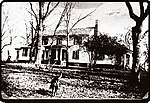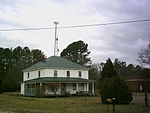Fort Powhatan

Fort Powhatan is a former river defense fort located at Windmill Hill (also called Hood's Bluff) near Garysville, Virginia, 2.5 miles (4.0 km) southeast of Flowerdew Hundred Plantation in Prince George County, Virginia. The fort was named for the area's Powhatan tribe of indigenous people; the name is also an English term for their leader. It is on the south bank of the James River, sited to prevent enemy vessels proceeding upriver to Richmond. The first fort on the site was a two-gun battery called Hood's Battery, built in 1779 during the American Revolutionary War and named after the owner of the plantation it was on. In January 1781, British forces under Benedict Arnold attacked and dismantled the battery and went on to burn Richmond. Later that year a larger fort was built, named Fort Hood (or Fort at Hood's Bluff). In 1808 this was replaced by the federal government with Fort Powhatan, part of what was later called the second system of US fortifications. The fort was not attacked in the War of 1812. In 1862, during the American Civil War, Confederate forces added a new earthwork battery on the site; the fort area was abandoned by Confederates, and subsequently captured by Union forces in July 1863. The fort was abandoned at the end of the war in 1865.
Excerpt from the Wikipedia article Fort Powhatan (License: CC BY-SA 3.0, Authors, Images).Fort Powhatan
Fort Powhatan Road,
Geographical coordinates (GPS) Address Nearby Places Show on map
Geographical coordinates (GPS)
| Latitude | Longitude |
|---|---|
| N 37.27 ° | E -77.0775 ° |
Address
Fort Powhatan Road 3050
23842
Virginia, United States
Open on Google Maps







